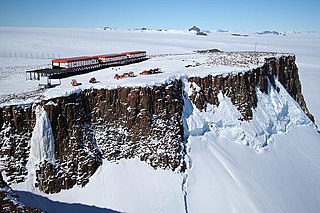 W
WResearch stations in Queen Maud Land are connected by the Dronning Maud Land Air Network Project (DROMLAN), which is a cooperative agreement for transportation between eleven nations with research stations in East Antarctica. Long-range aircraft fly between Cape Town, South Africa and either the Troll Airfield, located at the Troll research station, or the runway at the Novolazarevskaya Station. From these two main airfields, smaller aircraft may fly further to other Antarctic destinations.
 W
WAboa is a seasonal Finnish research station in Antarctica, located in Queen Maud Land, about 130 kilometres (81 mi) from the coast, on a nunatak called Basen in the Vestfjella Mountains.
 W
WThe Asuka Station is a permanent Japanese Antarctic unmanned observation base. It is located on Queen Maud Land and was opened in 1985.
 W
WDakshin Gangotri was the first scientific base station of India situated in Antarctica, part of the Indian Antarctic Programme. It is located at a distance of 2,500 kilometres (1,600 mi) from the South Pole. It is currently being used as a supply base and transit camp. The base is named after Dakshin Gangotri Glacier.
 W
WDome Fuji, also called Dome F or Valkyrie Dome, is an Antarctic base located in the eastern part of Queen Maud Land at 77°30′S 37°30′E. With an altitude of 3,810 m or 12,500 ft above sea level, it is the second-highest summit or ice dome of the East Antarctic ice sheet and represents an ice divide. Dome F is the site of Dome Fuji Station, a research station operated by Japan.
 W
WKohnen-Station is a German summer-only polar research station in the Antarctic, able to accommodate up to 20 people. It is named after the geophysicist Heinz Kohnen (1938–1997), who was for a long time the head of logistics at the Alfred Wegener Institute.
 W
WThe Mizuho Station was a permanent Japanese Antarctic transshipment station. Located on Mizuho Plateau 2230 m above sea level, it was opened in 1970. It was operated by the Japanese National Institute of Polar Research, and closed in 1987. It was occasionally visited by some parties for meteorological and glaciological observations.
 W
WNeumayer-Station or Neumayer-Station II was a permanent German Antarctic research base on Atka Bay. It opened in 1992, replacing the old Georg-von-Neumayer-Station.
 W
WThe Nordenskiöld Base is a name sometimes used for the facilities shared by the Antarctic stations Wasa (Sweden) and Aboa (Finland).
 W
WNovolazarevskaya Station is a Russian, formerly Soviet, Antarctic research station. The station is located at Schirmacher Oasis, Queen Maud Land, 75 km from the Antarctic coast, from which it is separated by Lazarev Ice Shelf. It was opened on January 18, 1961 by the 6th Soviet Antarctic Expedition. The maximum summer population is 70.
 W
WPlateau Station is an inactive American research and South Pole—Queen Maud Land Traverse support base on the central Antarctic Plateau. Construction on the site started on December 13, 1965, and the first traverse team arrived in early 1966. The base was in continuous use until January 29, 1969, when it was closed but mothballed for future use, and was the most remote and coldest of any United States stations on the continent. It was also the site for the world's coldest measured average temperature for a month at that time, recorded in July 1968, at −99.8 °F (−73.2 °C).
 W
WPrincess Elisabeth Antarctica, located on Utsteinen Nunatak in Queen Maud Land, is a Belgian scientific polar research station, which went into service on 15 February 2009.
 W
WSANAE is the South African National Antarctic Expedition. The name refers both to the overwintering bases, and the team spending the winter. The current base, SANAE IV, is located at Vesleskarvet in Queen Maud Land, Antarctica. Summer teams comprise administrative and maintenance personnel, helicopter crew and scientists from various countries and can be up to 100 people. Overwintering teams consist of scientists and support personnel from South Africa, typically totalling 10 members in recent years.
 W
WSANAE IV is a current South African Antarctic research base located in Vesleskarvet, Queen Maud Land. The base is part of the South African National Antarctic Program (SANAP) and is operated by the South African National Antarctic Expedition.
 W
WShowa Station , sometimes alternately spelled Syowa Station, is a Japanese permanent research station on East Ongul Island in Queen Maud Land, Antarctica. Built in 1957, Showa Station is named for the era in the Japanese calendar during which it was established, the Shōwa period.
 W
WThe Svea Research Station is a Swedish research facility in Antarctica, established in 1987/1988.
 W
WTor research station is a Norwegian Antarctic research station in Queen Maud Land.
 W
WTroll is a Norwegian research station located at Jutulsessen, 235 kilometers (146 mi) from the coast in the eastern part of Princess Martha Coast in Queen Maud Land, Antarctica. It is Norway's only all-year research station in Antarctica, and is supplemented by the summer-only station Tor. Troll is operated by the Norwegian Polar Institute and also features facilities for the Norwegian Meteorological Institute and the Norwegian Institute for Air Research.
 W
WThe Wasa Research Station is a Swedish research facility in Antarctica, established in 1988/1989. It is situated next to the Finnish Aboa Research Station on the Basen nunatak in the Kraul Mountains in Queen Maud Land. The two stations cooperate, and are jointly referred to as the Nordenskiöld Base Camp.